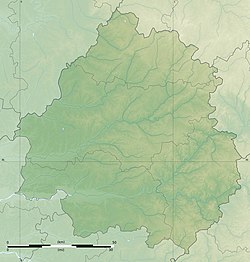
Back Höhle von Lascaux ALS كهف لاسكو Arabic لاسكو ARZ Lasko mağarası Azerbaijani Пячора Ласко Byelorussian Ласко Bulgarian Mougev Las Caus Breton Pećina Lascaux BS Coves de Lascaux Catalan Lascaux Czech
| UNESCO World Heritage Site | |
|---|---|
 Depiction of aurochs, horses and deer | |
| Location | Montignac, France |
| Part of | Prehistoric Sites and Decorated Caves of the Vézère Valley |
| Criteria | Cultural: i, iii |
| Reference | 85-011 |
| Inscription | 1979 (3rd Session) |
| Area | 34.34 ha (84+7⁄8 acres) |
| Coordinates | 45°03′13″N 1°10′12″E / 45.05361°N 1.17000°E |
| Lascaux | |
|---|---|
 | |
| Coordinates | 45°03′13″N 1°10′12″E / 45.05361°N 1.17000°E |
Lascaux (English: /læˈskoʊ/ la-SKOH,[1] US also /lɑːˈskoʊ/ lah-SKOH;[2] French: Grotte de Lascaux [ɡʁɔt də lasko],[3] "Lascaux Cave") is a network of caves near the village of Montignac, in the department of Dordogne in southwestern France. Over 600 parietal wall paintings cover the interior walls and ceilings of the cave. The paintings represent primarily large animals, typical local contemporary fauna that correspond with the fossil record of the Upper Paleolithic in the area. They are the combined effort of many generations. With continued debate, the age of the paintings is now usually estimated at around 17,000 - 22,000 years (early Magdalenian).[4][5][6] Because of the outstanding prehistoric art in the cave, Lascaux was inducted into the UNESCO World Heritage List in 1979, as an element of the Prehistoric Sites and Decorated Caves of the Vézère Valley.[7]
The original caves have been closed to the public since 1963, as their condition was quickly deteriorating, but there are now a number of replicas.
- ^ "American English Dictionary: Definition of Lascaux". Collins. Archived from the original on 27 September 2013. Retrieved 18 August 2013.
- ^ "Lascaux". Lexico US English Dictionary. Oxford University Press. Archived from the original on 16 April 2021.
- ^ "English Dictionary: Definition of Lascaux". Collins. Archived from the original on 27 September 2013. Retrieved 18 August 2013.
- ^ "Lascaux Cave Paintings: Layout, Meaning, Photographs – Dating – Chronological questions about the age of Lascaux's cave paintings, over what period they were created, and the identity of the oldest art in the complex, are still being debated..." Visual arts cork com. Archived from the original on 30 December 2016. Retrieved 28 December 2016.
- ^ "Ice Age star map discovered – thought to date back 16,500 years". BBC. 9 August 2000. Archived from the original on 18 April 2020. Retrieved 27 December 2016.
- ^ Lascaux, France. These paintings are estimated to be around 17,300 years old. Ancient-wisdom. 2000. Archived from the original on 28 December 2016. Retrieved 27 December 2016.
- ^ "Prehistoric Sites and Decorated Caves of the Vézère Valley". UNESCO World Heritage Centre. Archived from the original on 7 October 2019. Retrieved 30 December 2012.

